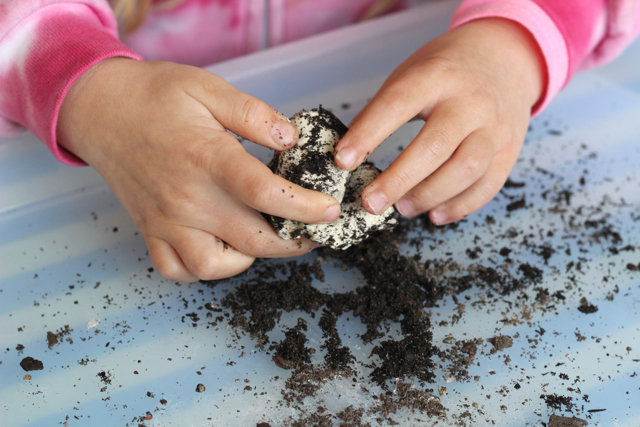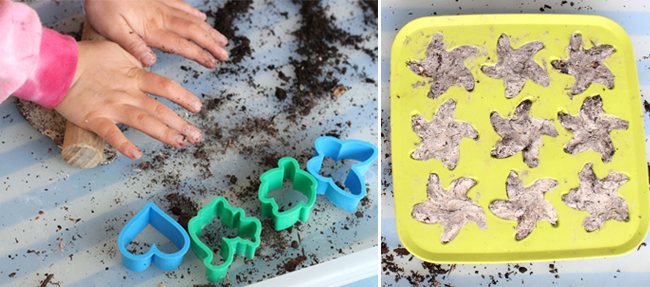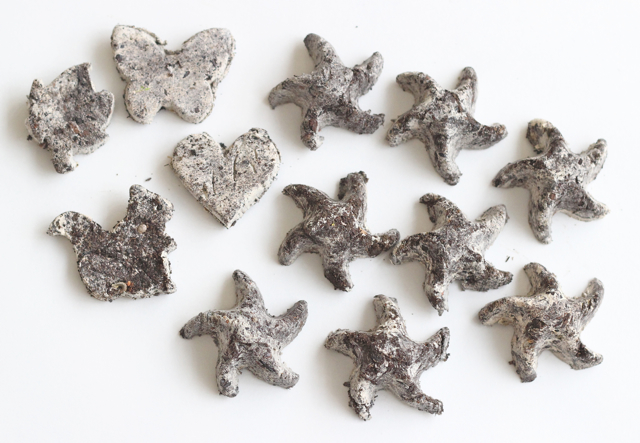
Wildflower Seed Bombs
How to make your own seed bombs:

Materials:
Air Dry Clay (affiliate link)
Soil
Native wildflower seeds (for the good of the ecosystem, make sure to use wildflowers native to your region)
Dough Tool Set (affiliate link) or Silicone Mold
Optional: Water spritzer (only use if the clay starts to dry out)
Optional: Tray for keeping the mess contained
Steps:
1) Start with a small ball of clay, a smaller amount of soil, and an even smaller pile of seeds on your tray or table.

2) Have your child knead the clay while rolling it into the soil and seeds. Don’t be afraid to get messy and have fun! Continue adding more soil and seeds until the soil gets mixed in well. There is no exact ratio needed, just enough soil to help the seeds grow, but not too much as to make the ball crumble.

3) To create seed bomb shapes, you can either press the clay into a mold (like a silicone ice cube tray) or roll it out and use cookie cutters. Karuna tried out our Dough Tool Set, which turned out to be the perfect size and depth for seed bombs.

4) Let dry (if you use a mold, let the seed bombs dry in the mold before taking them out)

With seed bombs in tow, go for a walk around the city in search of abandoned plots. Your child will love launching the seed bombs into open space! If you’re worried about the legality of seed-bombing, check with your local authorities. Otherwise, use them in your own yard or planter box to see them in action. After weeks of rain and sun, your wildflowers should begin to sprout, adding color and beauty to an otherwise blank canvas of land. Happy planting!





Do not use “air dry clay” for this. Air dry clay has glue in it and it will not slake down as normal clay should. Use clay mixed with water or basically any clay that you’d have to fire in a kiln. If you use “air dry clay” as pictured you are essentially gluing seeds, dirt and clay together and when the rains come it will not break down as expected.
Thanks for the info, Allison. I did some research before posting this project and the ingredients are impossible to find because they are proprietary. Crayola says that it is a “natural earth clay” so I figured it would be okay for the ground, but I guess you can’t always trust the description. For those of you reading this, I’m not sure if it has glue in it, but it does seem to work fine for seed bombs. If you want to try something else, you can swap it out for a firing clay at your local art supply store or try this 5lb bag of firing clay on Amazon: https://www.amazon.com/Activa-Blackjack-5-Pound-Dries-Light/dp/B002VR0C0I
We will be using potter’s clay that was donated by a local artist for our seed bomb project this Thursday! A collaboration between the Yellowstone County Master Gardeners and the Billings Public Library, Billings, MT.
That’s awesome, Tracy! Let me know how it goes :)
do you have to bake it to dry it of using the potter’s clay?
Hi Jennifer,
No you don’t have to bake the potter’s clay. It will dry naturally.